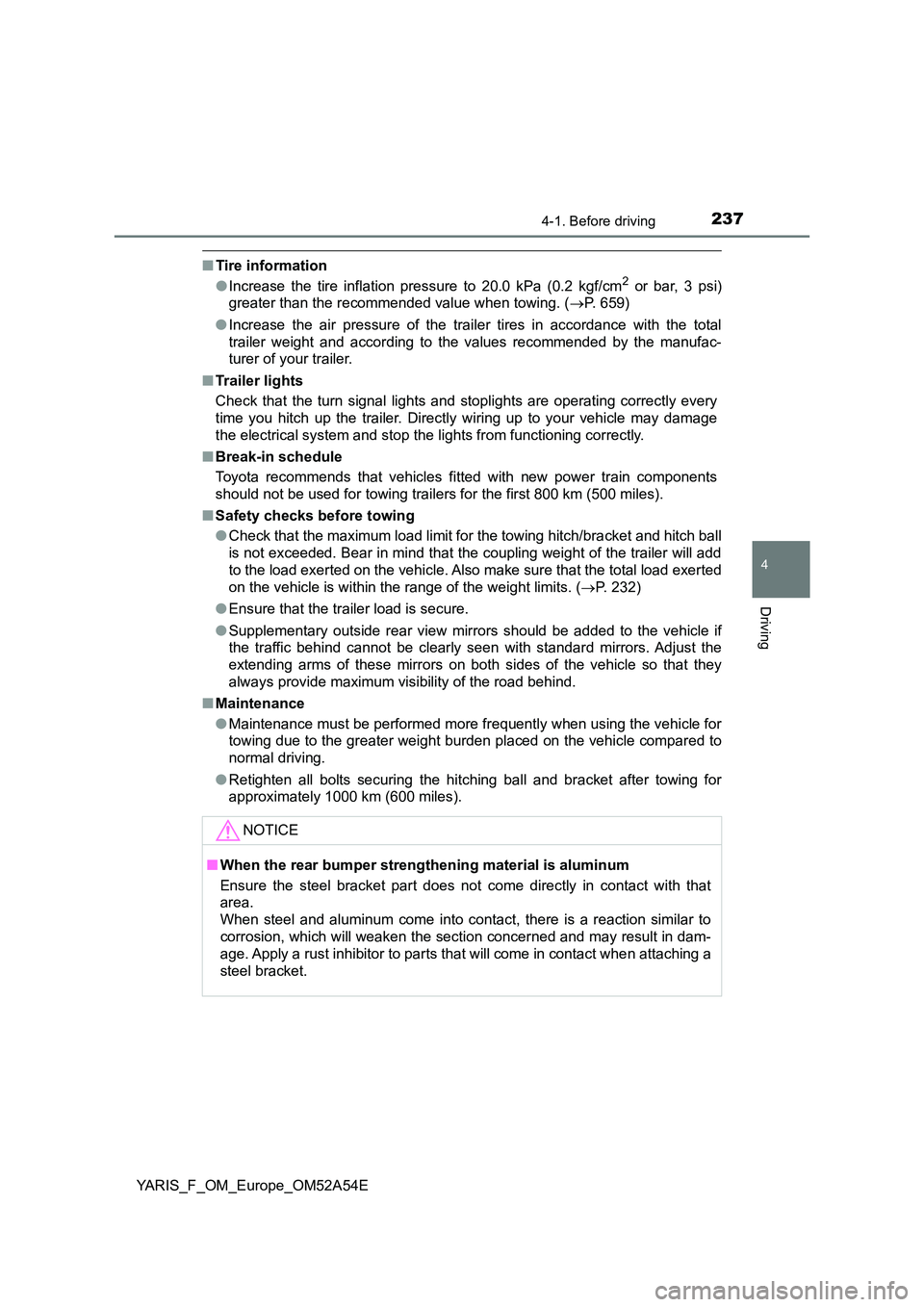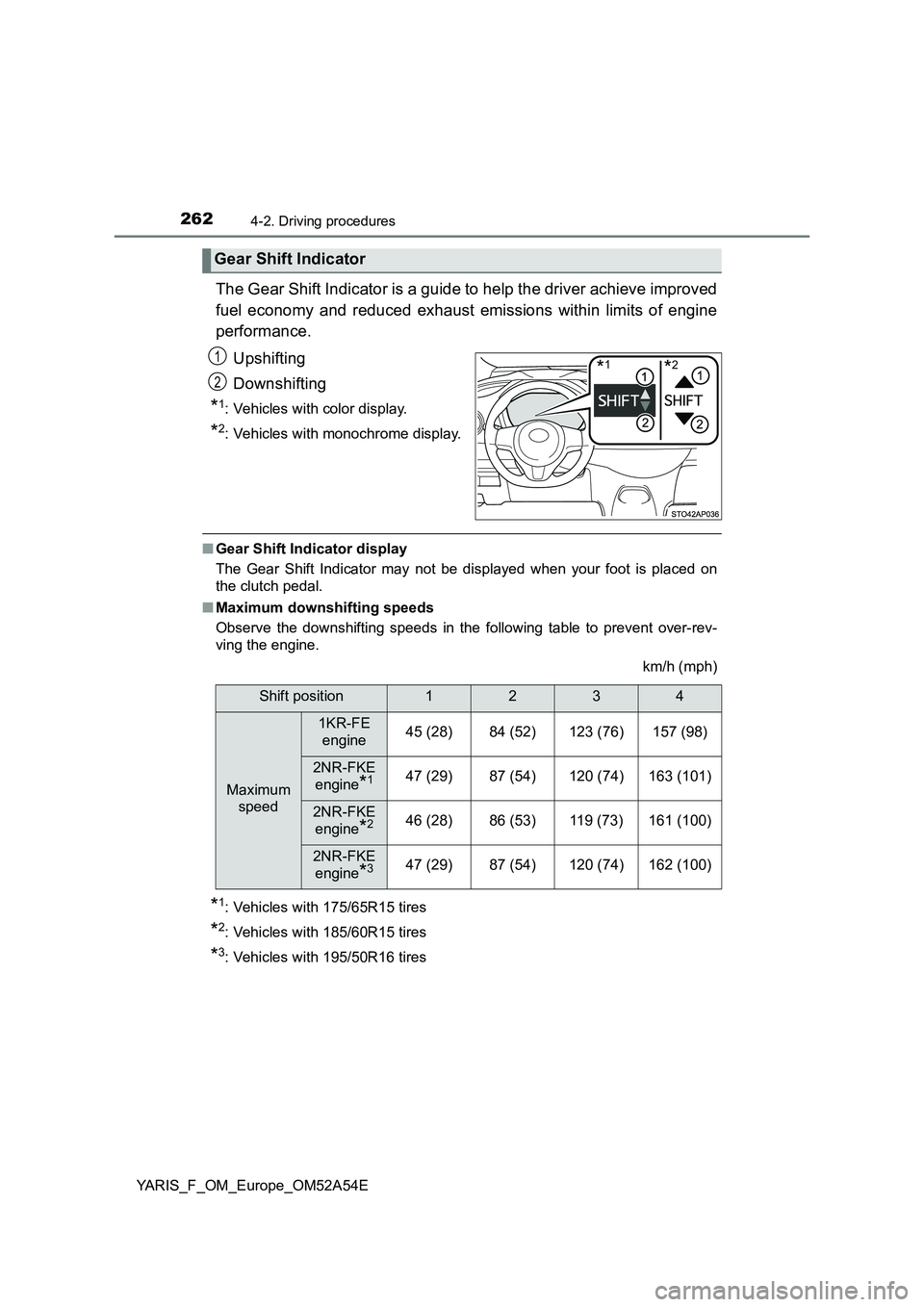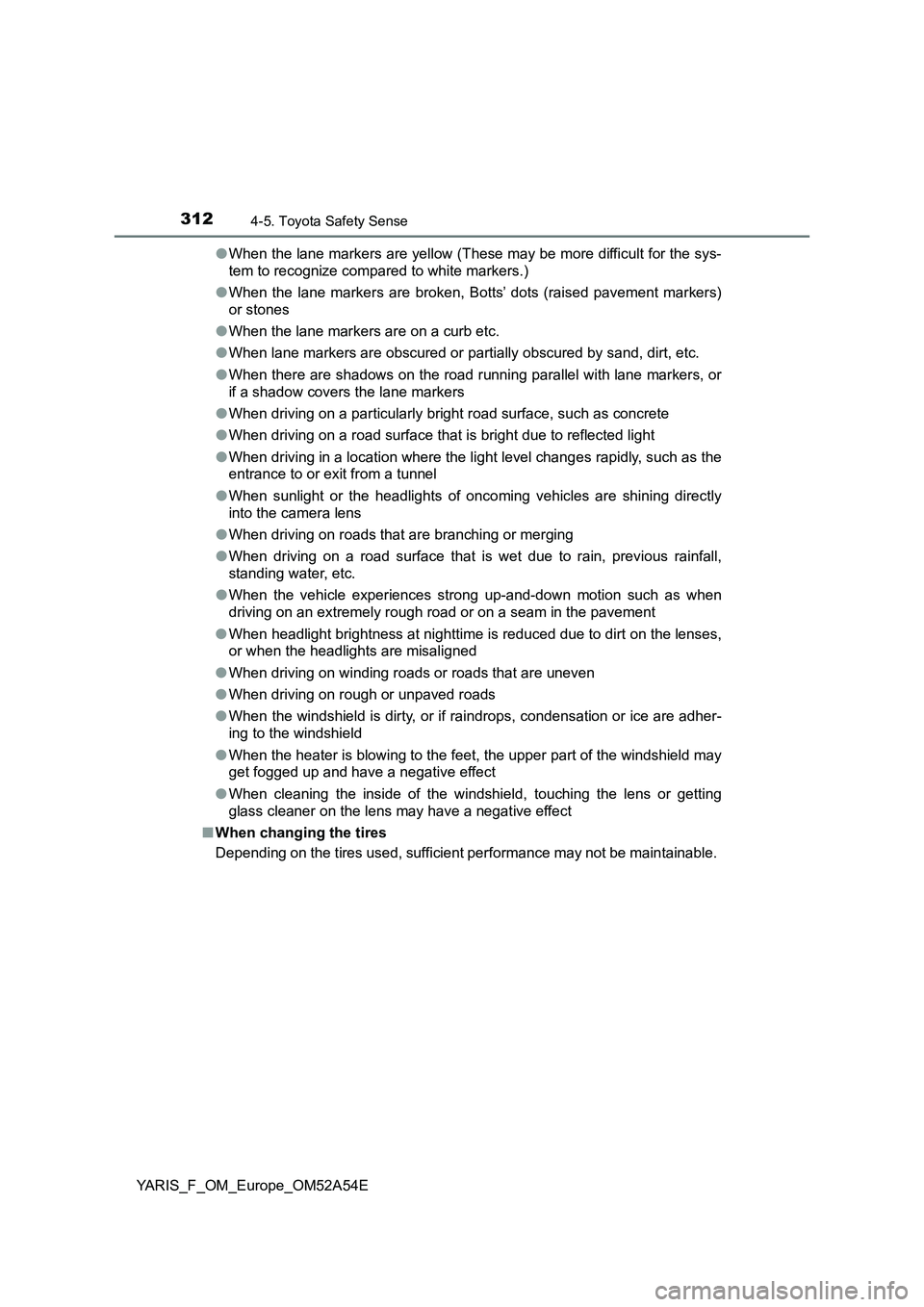2019 TOYOTA YARIS HATCHBACK tires
[x] Cancel search: tiresPage 6 of 692

TABLE OF CONTENTS6
YARIS_F_OM_Europe_OM52A54E
6-4. Using the other interior
features
Other interior features ........470
• Sun visors ......................470
• Vanity mirrors ................470
• Portable ashtray ............472
• Cigarette lighter .............473
• Power outlet ..................474
• Armrest ..........................475
• Panoramic roof shade ...475
• Assist grips ....................476
7-1. Maintenance and care
Cleaning and protecting
the vehicle exterior ..........478
Cleaning and protecting
the vehicle interior ...........482
7-2. Maintenance
Maintenance
requirements....................485
7-3. Do-it-yourself maintenance
Do-it-yourself service
precautions ......................488
Hood ..................................491
Positioning a floor jack .......493
Engine compartment ......... 495
Tires .................................. 508
Tire inflation pressure........ 528
Wheels .............................. 530
Air conditioning filter .......... 534
Wireless remote control/
electronic key battery ...... 537
Checking and replacing
fuses ............................... 541
Light bulbs ......................... 547
8-1. Essential information
Emergency flashers .......... 568
If your vehicle has to
be stopped in
an emergency ................. 569
If the vehicle is
trapped in rising water..... 571
8-2. Steps to take in
an emergency
If your vehicle needs to
be towed ......................... 572
If you think something is
wrong .............................. 579
Fuel pump
shut off system ............... 580
7Maintenance and care8When trouble arises
Page 15 of 692

15Pictorial index
YARIS_F_OM_Europe_OM52A54EWiper. . . . . . . . . . . . . . . . . . . . . . . . . . . . . . . . . . . . . . . . P. 273, 277
Precautions against winter season . . . . . . . . . . . . . . . . . . . . . P. 362
Precautions against car wash . . . . . . . . . . . . . . . . . . . . . . . . . P. 479
Fuel filler door . . . . . . . . . . . . . . . . . . . . . . . . . . . . . . . . . . . . P. 279
Refueling method . . . . . . . . . . . . . . . . . . . . . . . . . . . . . . . . . . P. 279
Fuel type/fuel tank capacity . . . . . . . . . . . . . . . . . . . . . . . . . . . P. 650
Tires . . . . . . . . . . . . . . . . . . . . . . . . . . . . . . . . . . . . . . . . . . . . P. 508
Tire size/inflation pressure . . . . . . . . . . . . . . . . . . . . . . . . . . . . P. 659
Winter tires/tire chain . . . . . . . . . . . . . . . . . . . . . . . . . . . . . . . . P. 364
Checking/rotation/tire pressure warning system
*3 . . . . . . . . . P. 508
Coping with flat tires . . . . . . . . . . . . . . . . . . . . . . . . . . . . P. 596, 614
Hood . . . . . . . . . . . . . . . . . . . . . . . . . . . . . . . . . . . . . . . . . . . . P. 491
Opening . . . . . . . . . . . . . . . . . . . . . . . . . . . . . . . . . . . . . . . . . . P. 491
Engine oil . . . . . . . . . . . . . . . . . . . . . . . . . . . . . . . . . . . . . . . . . P. 650
Coping with overheat . . . . . . . . . . . . . . . . . . . . . . . . . . . . . . . . P. 639
Headlights/front position lights/
daytime running lights . . . . . . . . . . . . . . . . . . . . . . . . . . . . . P. 266
Front turn signal lights . . . . . . . . . . . . . . . . . . . . . . . . . . . . . P. 264
Front fog lights
*3. . . . . . . . . . . . . . . . . . . . . . . . . . . . . . . . . . P. 271
Side turn signal lights . . . . . . . . . . . . . . . . . . . . . . . . . . . . . . P. 264
Rear turn signal lights. . . . . . . . . . . . . . . . . . . . . . . . . . . . . . P. 264
Back up lights/tail lights (LED type) . . . . . . . . . . . . . . . . . . P. 266
Shifting the shift lever to R. . . . . . . . . . . . . . . . . . . . . . . . P. 252, 260
Stop/tail lights . . . . . . . . . . . . . . . . . . . . . . . . . . . . . . . . . . . . P. 266
Rear fog light . . . . . . . . . . . . . . . . . . . . . . . . . . . . . . . . . . . . . P. 271
License plate lights . . . . . . . . . . . . . . . . . . . . . . . . . . . . . . . . P. 266
4
5
6
7
Light bulbs of the exterior lights for driving
(Replacing method: P. 547, Watts: P. 663)
*1: Vehicles with a smart entry & start system
*2: Vehicles with monochrome display
*3: If equipped
8
9
10
11
12
13
14
15
Page 223 of 692

2234-1. Before driving
4
Driving
YARIS_F_OM_Europe_OM52A54E
■When starting off on an uphill
The hill-start assist control will activate. (P. 358)
■Driving in the rain
●Drive carefully when it is raining, because visibility will be reduced, the win-
dows may become fogged-up, and the road will be slippery.
●Drive carefully when it starts to rain, because the road surface will be espe-
cially slippery.
●Refrain from high speeds when driving on an expressway in the rain,
because there may be a layer of water between the tires and the road sur-
face, preventing the steering and brakes from operating properly.
■Engine speed while driving (vehicles with a Multidrive)
In the following conditions, the engine speed may become high while driving.
This is due to automatic up-shifting control or down-shifting implementation to
meet driving conditions. It does not indicate sudden acceleration.
●The vehicle is judged to be driving uphill or downhill
●When the accelerator pedal is released
●When the brake pedal is depressed while sport mode is selected
■Breaking in your new Toyota
To extend the life of the vehicle, observing the following precautions is recom-
mended:
●For the first 300 km (200 miles):
Avoid sudden stops.
●For the first 800 km (500 miles):
Do not tow a trailer.
●For the first 1000 km (600 miles):
• Do not drive at extremely high speeds.
• Avoid sudden acceleration.
• Do not drive continuously in low gears.
• Do not drive at a constant speed for extended periods.
■Operating your vehicle in a foreign country
Comply with the relevant vehicle registration laws and confirm the availability
of the correct fuel. (P. 664)
Page 237 of 692

2374-1. Before driving
4
Driving
YARIS_F_OM_Europe_OM52A54E
■Tire information
● Increase the tire inflation pressure to 20.0 kPa (0.2 kgf/cm2 or bar, 3 psi)
greater than the recommended value when towing. ( P. 659)
● Increase the air pressure of the trailer tires in accordance with the total
trailer weight and according to the values recommended by the manufac-
turer of your trailer.
■ Tr a i l e r l i g h ts
Check that the turn signal lights and stoplights are operating correctly every
time you hitch up the trailer. Direct ly wiring up to your vehicle may damage
the electrical system and stop the lights from functioning correctly.
■ Break-in schedule
Toyota recommends that vehicles fitted with new power train components
should not be used for towing trailers for the first 800 km (500 miles).
■ Safety checks before towing
● Check that the maximum load limit for the towing hitch/bracket and hitch ball
is not exceeded. Bear in mind that the coupling weight of the trailer will add
to the load exerted on the vehicle. Also make sure that the total load exerted
on the vehicle is within the range of the weight limits. ( P. 232)
● Ensure that the trailer load is secure.
● Supplementary outside rear view mirrors should be added to the vehicle if
the traffic behind cannot be clearly seen with standard mirrors. Adjust the
extending arms of these mirrors on both sides of the vehicle so that they
always provide maximum visibility of the road behind.
■ Maintenance
● Maintenance must be performed more frequently when using the vehicle for
towing due to the greater weight burden placed on the vehicle compared to
normal driving.
● Retighten all bolts securing the hitching ball and bracket after towing for
approximately 1000 km (600 miles).
NOTICE
■ When the rear bumper strengthening material is aluminum
Ensure the steel bracket part does not come directly in contact with that
area.
When steel and aluminum come into contact, there is a reaction similar to
corrosion, which will weaken the section concerned and may result in dam-
age. Apply a rust inhibitor to parts that will come in contact when attaching a
steel bracket.
Page 262 of 692

2624-2. Driving procedures
YARIS_F_OM_Europe_OM52A54E
The Gear Shift Indicator is a guide to help the driver achieve improved
fuel economy and reduced exhaust emissions within limits of engine
performance.
Upshifting
Downshifting
*1: Vehicles with color display.
*2: Vehicles with monochrome display.
■Gear Shift Indicator display
The Gear Shift Indicator may not be displayed when your foot is placed on
the clutch pedal.
■Maximum downshifting speeds
Observe the downshifting speeds in the following table to prevent over-rev-
ving the engine.
km/h (mph)
*1: Vehicles with 175/65R15 tires
*2: Vehicles with 185/60R15 tires
*3: Vehicles with 195/50R16 tires
Gear Shift Indicator
*1*21
2
Shift position1234
Maximum
speed
1KR-FE
engine45 (28)84 (52)123 (76)157 (98)
2NR-FKE
engine
*147 (29)87 (54)120 (74)163 (101)
2NR-FKE
engine
*246 (28)86 (53)119 (73)161 (100)
2NR-FKE
engine
*347 (29)87 (54)120 (74)162 (100)
Page 293 of 692

2934-5. Toyota Safety Sense
4
Driving
YARIS_F_OM_Europe_OM52A54E
WARNING
■Pre-crash braking
● While driving, such as when driving through a railway crossing, the system
may determine that the possibility of a collision with an object, such as rail-
way crossing barrier, is high and operate the pre-crash braking function.
To move the vehicle in an emergency, such as if the system operates in a
railway crossing, perform the following operations and then take the nec-
essary measures to ensure your safety.
• If the vehicle has been stopped, depress the accelerator pedal.
•If the vehicle is decelerating, fully depress the accelerator pedal.
( P. 297)
• Disable the pre-crash safety system. ( P. 294)
■ When to disable the pre-crash safety system
In the following situations, disable the system, as it may not operate prop-
erly, possibly leading to an accident resulting in death or serious injury:
● When the vehicle is being towed
● When your vehicle is towing another vehicle
● When transporting the vehicle via truck, boat, train or similar means of
transportation
● When the vehicle is raised on a lift with the engine running and the tires
are allowed to rotate freely
● When inspecting the vehicle using a drum tester such as a chassis dyna-
mometer or speedometer tester, or when using an on vehicle wheel bal-
ancer
● If the vehicle cannot be driven in a stable manner, such as when the vehi-
cle has been in an accident or is malfunctioning
● When the vehicle is driven in a sporty manner or off-road
● When the condition of the tires is poor and they do not perform well
( P. 508)
● When tires of a size other than specified are installed
● When tire chains are installed
● When a compact spare tire or an emergency tire puncture repair kit is used
Page 304 of 692

3044-5. Toyota Safety Sense
YARIS_F_OM_Europe_OM52A54E
• If the wheels are misaligned
• If a wiper blade is blocking the front sensor • The vehicle is wobbling.• The vehicle is being driven at extremely high speeds.
• When driving on roads with sharp bends or uneven surfaces • When a preceding vehicle is a poor reflector of laser
● In some situations such as the following, sufficient braking force may not be
obtained, preventing the system from performing properly:
• If the braking functions cannot operate to their full extent, such as when the brake parts are extremely cold, extremely hot, or wet• If the vehicle is not properly maintained (brakes or tires are excessively worn,
improper tire inflation pressure, etc.) • When the vehicle is being driven on a gravel road or other slippery surface
• If your vehicle is skidding
• When the front part of the vehicle is
raised or lowered
• When the sensor is misaligned due to
a strong impact being applied to the
sensor, etc.
Page 312 of 692

3124-5. Toyota Safety Sense
YARIS_F_OM_Europe_OM52A54E●When the lane markers are yellow (These may be more difficult for the sys-
tem to recognize compared to white markers.)
●When the lane markers are broken, Botts’ dots (raised pavement markers)
or stones
●When the lane markers are on a curb etc.
●When lane markers are obscured or partially obscured by sand, dirt, etc.
●When there are shadows on the road running parallel with lane markers, or
if a shadow covers the lane markers
●When driving on a particularly bright road surface, such as concrete
●When driving on a road surface that is bright due to reflected light
●When driving in a location where the light level changes rapidly, such as the
entrance to or exit from a tunnel
●When sunlight or the headlights of oncoming vehicles are shining directly
into the camera lens
●When driving on roads that are branching or merging
●When driving on a road surface that is wet due to rain, previous rainfall,
standing water, etc.
●When the vehicle experiences strong up-and-down motion such as when
driving on an extremely rough road or on a seam in the pavement
●When headlight brightness at nighttime is reduced due to dirt on the lenses,
or when the headlights are misaligned
●When driving on winding roads or roads that are uneven
●When driving on rough or unpaved roads
●When the windshield is dirty, or if raindrops, condensation or ice are adher-
ing to the windshield
●When the heater is blowing to the feet, the upper part of the windshield may
get fogged up and have a negative effect
●When cleaning the inside of the windshield, touching the lens or getting
glass cleaner on the lens may have a negative effect
■When changing the tires
Depending on the tires used, sufficient performance may not be maintainable.